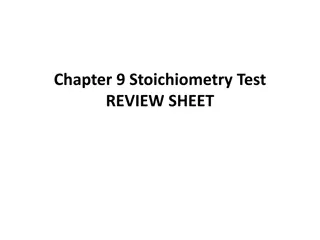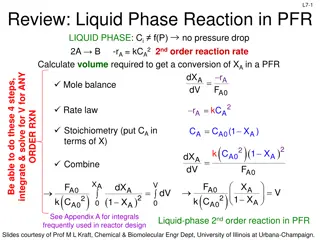Understanding Stoichiometry in Chemical Reactions
Stoichiometry in chemical reactions involves mass changes, limiting reactants, and calculating yields like moles and grams. Learn to solve problems involving different reactants and products, determining the quantities involved in a reaction. Examples cover decompositions, formations, and calculations. Illustrations and analogies provide a clearer understanding of these concepts.
Download Presentation

Please find below an Image/Link to download the presentation.
The content on the website is provided AS IS for your information and personal use only. It may not be sold, licensed, or shared on other websites without obtaining consent from the author. Download presentation by click this link. If you encounter any issues during the download, it is possible that the publisher has removed the file from their server.
E N D
Presentation Transcript
Stoichiometry Mass Changes in Chemical Reactions Limiting reactants Percentage yield
Stoichiometry Problems How many moles of KClO3must decompose in order to produce 9 moles of oxygen gas? Example 1 Problem: X molKClO3 2KClO3 Balanced : 2 molKClO3 Equation 9mol O2 2KCl + 3O2 3mol O2 XmolKClO3 9 2 molO = molKClO3 2 3molO2 = 6 mol KClO3
Stoichiometry Problems How many grams of silver will be formed when 12 g of copper reacts with aluminum nitrate to produce silver and copper II nitrate and silver? Example 2 Problem: 12gCu Cu + 2 AgNO3 Xg Ag 2 Ag + Cu(NO3)2 Balanced: 63.5 gCu Equation 215.8 g 2(107.9) g Ag XgAg 12 gCu = 215.8gAg 63.5gCu = 41 g Ag
Stoichiometry Problems If 12.0 grams of potassium chlorate decompose, how many moles of potassium chloride will be produced? Example 3 Problem: 12gKClO3 2 KClO3 X moles KCl 2KCl + 3 O2 Balanced: 2(122.6) g KClO3 Equation 245.2 g 2 moles KCl Xmol KCl 12 3 gKClO = molKCl 2 245.2 gKClO3 = 0.0988 mol KCl
Stoichiometry Problems In an experiment, red mercury (II) oxide powder is placed in an open flask and heated until it is converted to liquid mercury and oxygen gas. The liquid mercury has a mass of 92.6 g. What is the mass of oxygen formed in the reaction? Problem: 92.6 g Hg + X g O2 2HgO 2Hg + O2 Balanced: 2 ( 200.6) g Hg + 32 g O2 Equation 401.2 g Hg LEARNING CHECK Xg O2 92 6 . gHg = 32g O2 401.2 g Hg = 7.39 g O2
Bike Analogy Consider the following Analogy: 2 Wheels + 1 Body + 1 Handle bar + 1 Gear Chain = 1 bike How many bikes can be produced given, 8 wheels, 5 bodies, 6 handle bar and 5 gear chain?
Bike Analogy Consider the following Analogy: 2 Wheels + 1 Body + 1 Handle bar + 1 Gear Chain = 1 bike How many bikes can be produced given, 8 wheels, 5 bodies, 6 handle bar and 5 gear chain? Limiting Reactant Excess Reactant
Cheeseburger Analogy Consider the following Analogy: 2 Cheese + 1 burger patty + 1 bun = cheese burger Given three hamburger patties, six buns, and 12 slices of cheese, how many cheese burger can be made?
Cheeseburger Analogy Consider the following Analogy: 2 Cheese + 1 burger patty + 1 bun = 1 cheese burger LR Given three hamburger patties, six buns, and 12 slices of cheese, how many cheese burger can be made? ER
Limiting Reactant vs. Excess Reactants Limiting reactant is the reactant that runs out first In our examples, the limiting reactants will be the wheels in the bicycle analogy and the burger patty in our hamburger analogy When the limiting reactant is exhausted, then the reaction stops
Limiting Reactants Calculations 1. Write a balanced equation. 2. For each reactant, calculate the amount of product formed. 3. The reactant that resulted in the smallest amount of product is the limiting reactant(LR). 4. To find the amount of leftover reactant excess calculate the amount of the no LR used by the LR. 5. Subtract the calculated amount in step 4 from the original no LR amount given in the problem.
Example 1 Determine how many moles of water can be formed if I start with 2.75 moles of hydrogen and 1.75 moles of oxygen. Problem: 2.75 mol H2 2H2 + O2 Balanced: 2 mol H2 Equation XmolH2O= XmolH2O 2H2O 2molH2O Limiting reactant =H2 2.75 mol H2 = 2.75 mol H2O 2molH2O mol 2 H2 Problem: 1.75 mol O2 2H2 + O2 Balanced: 1 mol O2 Equation XmolH2O= XmolH2O 2H2O 2molH2O 1.75 mol O2 = 3.50 mol H2O 2molH2O mol 1 O2
Example 2 If 2.0 mol of HF are exposed to 4.5 mol of SiO2, which is the limiting reactant? Problem: 2.0 mol HF SiO2(s) + 4HF(g) Balanced: 4 mol HF Equation XmolH2O= XmolH2O SiF4(g) + 2H2O(l) 2molH2O 2.0mol HF = 1.0 mol H2O molH2O 2 4.0mol HF Limiting reactant =HF Problem: 4.5 mol SiO2 SiO2(s) + 4HF(g) Balanced: 1 mol SiO2 Equation XmolH2O= XmolH2O SiF4(g) + 2H2O(l) 2molH2O 4.5molSiO2 = 9.0 mol H2O molH2O 2 1.0molSiO2
LEARNING CHECK If 36.0 g of H2O is mixed with 167 g of Fe , which is the limiting reactant? Problem: 36.0 g H2O 2Fe(s) + 3H2O(g) Balanced: 54 g H2O Equation XgFe2O3 XgFe2O3 Fe2O3(g) + 3H2(g) 159.6gFe2O3 36.0g H2O = 106 g Fe2O3 = 159.6gFe2O 3 54.0gH2O Limiting reactant =H2O Problem: 167 g Fe 2Fe(s) + 3H2O(g) Balanced: 111.6 g Fe Equation XgFe2O3 XgFe2O3 Fe2O3(g) + 3H2(g) 159.6gFe2O3 167g Fe = 238 g Fe2O3 = 159.6gFe2O 3 111.6 gFe
Limiting Reactants Calculations 1. Write a balanced equation. 2. For each reactant, calculate the amount of product formed. 3. The reactant that resulted in the smallest amount of product is the limiting reactant(LR). 4. To find the amount of leftover reactant excess calculate the amount of the no LR used by the LR. 5. Subtract the calculated amount in step 4 from the original no LR amount given in the problem.
Limiting Reactants LR XS 3Fe(s) + 4H2O(g) Fe3O3(g) + 4H2(g) Limiting reactant: H2O Excess reactant: Fe Products Formed: 107 g Fe3O3 & 4.00 g H2 3Fe(s) + 4H2O(g) Balanced: 111.6 g Fe 54 g H2O Equation 36gH2O 111.6gFe Problem: XgFe 36.0 g H2O Fe3O3(g) + 4H2(g) XgFe = = 74.4 g Fe used gH2O 54 167gFe - 74.4 g Fe= 92.6 g Fe Original Used = Excess left over iron
Percent Yield So far, the masses we have calculated from chemical equations were based on the assumption that each reaction occurred 100%. The THEORETICAL YIELD the maximum amount of product that can be produced in a reaction (calculated from the balanced equation) The ACTUAL YIELD is the amount of product that is actually produced in an experiment (usually less than the theoretical yield)
Percent Yield Theoretical Yield the maximum amount of product that can be produced in a reaction Percent Yield The actual amount of a given product as the percentage of the theoretical yield.
Look back at the problem from LEARNING CHECK. We found that 106 g Fe2O3could be formed from the reactants. In an experiment, you formed 90.4 g of Fe2O3. What is your percent yield? % Yield = 90.4 g 106 g x 100 = 85.3%
Example 1 A 10.0 g sample of ethanol, C2H5OH, was boiled with excess acetic acid, CH3COOH, to produce 14.8 g of ethyl acetate, CH3COOC2H5. What percent yield of ethyl acetate is this? Problem: 10.0gC2H5OH CH3COOH + C2H5OH Xg CH3COOC2H5 CH3COOC2H5 + H2O Balanced: 46.0 gC2H5OH Equation XgCH3COOC2 88.0 g CH3COOC2H5 H5 10 0 . C2H5OH g = 88.0gCH3CO OC2H5 46.0gC2H5O H = 19.1 g CH3COOC2H5 % Yield = 14.8 g 19.1g x 100 = 77.5%
LEARNING CHECK When 36.8 g of C6H6 reacts with Cl2, what is the theoretical yield of C6H5Cl produced? If the actual is 43.7 g, determine the percentage yield of C6H5Cl. Xg C5H5Cl 2C6H5Cl + H2 Problem: 36.8gC5H5 2C6H6 + Cl2 Balanced: 156.0 gC5H5 Equation XgC6H5Cl 225.0 g C5H5Cl 36 8 . 6 6 gC H = 225.0gC6H5 Cl 156 0 . 6 6 gC H = 53.1 g C6H5Cl % Yield = 43.7 g 53.1g x 100 = 88.3%























